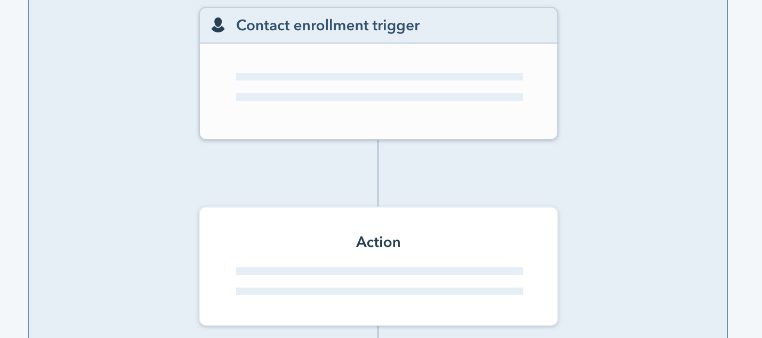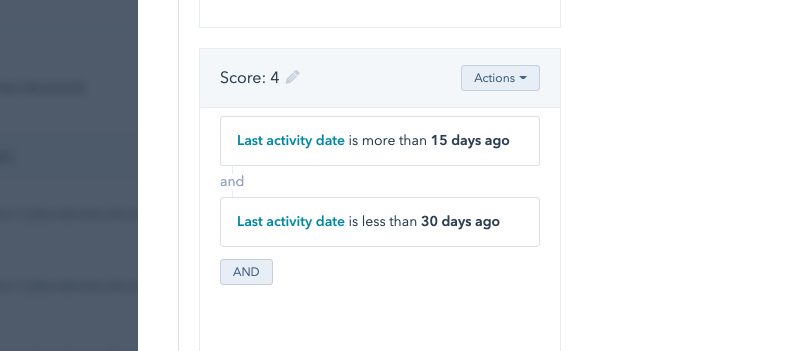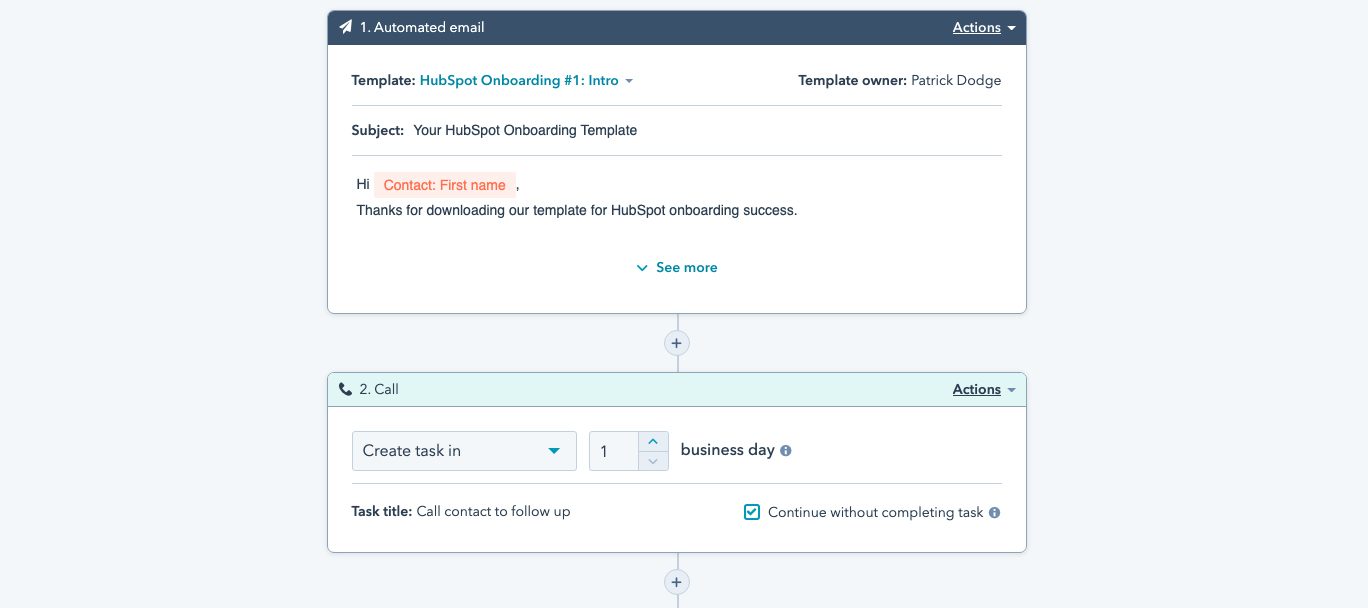How often does your sales team hear the words: “Work smarter, not harder?”
This sounds like a good idea, but what does this mean in a practical sense? No one wants to work harder than they have to.
Sometimes, a good step forward simply using sales automation tools to streamline tasks that don’t need to be managed manually.
We use HubSpot’s Sales Hub to keep processes lean, save time, and improve outcomes. Here are a few automations that will help your company as well.
Qualifying Leads in Sales Process Automation
Marketing and Sales often disagree about whether the leads that come in are truly good or not.
Sales process automation can help solve that by creating a uniform standard for identifying a lead that’s truly a good fit for the services your company provides.
The first step is to bring the leadership team together and decide what your ideal customer profile, or ICP, looks like.
An Ideal Customer Profile defines the type of company that makes a great customer for your business, determined by characteristics like the annual revenue, number of employees, industry, or the geographic location.
Once you have your ICP nailed down, you’re ready to apply it in sales process automation that will help you streamline the process.
1. Set Trigger Criteria in the Sales Automation System.

Trigger criteria kicks off the automated workflows in which contacts are auto-enrolled.
It tells the platform – when a contact meets certain criteria, enroll the person into this automated sequence.
Sometimes the trigger is based on user actions — like filling out a form or abandoning a shopping cart – or on properties you’ve gathered about them in the CRM.
In this example, the sales automation tools will be triggered by a user action indicating they need attention from Sales.
2. Qualify Leads Using Your Ideal Customer Profile.
Use conditional logic in your automation to vet the lead according to your ideal customer profile.
An if/then branch can determine whether you have a good match for any properties that are important to you:
- Industry type
- Company size
- Geographic location
- Products and services
- B2B or B2C
- Annual revenue
Setting up conditional logic will enable the workflow to sort your leads, based on whether they meet your defined criteria.
Regardless of the qualifying properties you choose, they have to be captured and stored in the CRM before you can use them in sales automation processes.
{{cta(‘cdf4071a-fc7d-4dea-9c83-b56e4b4eecc5’)}}
3. Update the Lifecycle Stage Property in the CRM.
When your automation identifies a qualified lead, and the contact is showing signs they are evaluating a solution, you will likely want to update their lifecycle stage.
Lifecycle stages give you perspective about where the prospect is in their decision making, and whether the lead is qualified.

If a previously unknown visitor fills out an form on your website for basic educational material about a challenge they are experiencing, you’ve got an unqualified lead that’s in the Awareness stage of the journey.
Once that lead explores information that covers potential solutions (including yours), and they meet your ICP criteria, then they’ve advanced to the Consideration or Decision stage.
You’ve likely got a marketing qualified lead on your hands, and they are ready for contact with Sales.
You can program the automation to change the contact’s lifecycle stage property to MQL, making the lead easy to prioritize in the CRM.
Once an MQL is identified, it’s time to get Sales in on the fun.
“Before investing in a sales automation platform, make sure Sales is living and breathing in the company CRM. You cannot reap the benefits when the team is not working out of the CRM every day.”
4. Assign Lead to a Salesperson.
A marketing qualified lead is just that – a prospect your automation thinks might be a good fit.
Now, we need to assign the lead to a salesperson who can determine if we are dealing with a sales qualified lead.
The next step in the sales process automation will assign the contact to a salesperson. With HubSpot, you can assign leads to a single individual, or a group of people round-robin style.
5. Assign a Deal to a Salesperson.
The next step is creating and assigning a deal for the salesperson.
This is useful if your business is mostly transactional and you are pretty certain a qualified lead belongs in your sales pipeline right away.
If this is the case, you can tell the automation to create a deal and make the sales rep (assigned to the contact in the previous step) the deal owner as well.
5. Send Notifications to Sales.
The last stage in this sequence sends a notification to everyone who needs to know a qualified lead is ready for contact from Sales.
In HubSpot Sales Hub, you send notifications through email, SMS, or Slack. If you have field reps on staff, it might be easier to reach them through a text message rather than email.
Regardless of the method for reaching them, make sure someone from the team responds right away! A response within seconds or minutes after a sales inquiry can dramatically increase your chances of winning the business.
With this in mind, you can add another step in your sequence that sends a second alert if no one has responded to the lead within a certain period of time. Fifteen minutes is a good timeframe.
Related Content: How to Build a “Sales-Friendly” Website
Lead Scoring in Sales Automation

Another important tool for qualifying leads is lead scoring.
This is where you assign numeric values to specific characteristics of your lead and their behaviors on your company website, and the system automatically scores a lead using those values.
You might assign numbers to characteristics that match your ICP, or to what the contact does as they navigate your website. All of these insights can be tracked on your automation platform and stored in your CRM.
Lead scoring is useful not only for figuring out if your prospect is the right fit, but also for spotting buying signals, or at least signs they’re considering a solution your team provides.
And not all actions a lead takes are equal.
For example, if they “like” one of your Facebook posts, does that action carry the same weight as filling out a form on your website for a product demo? Of course not.
So, it’s important to make sure your scoring weighs heavier on actions that are more important. There are a number of different behaviors you can score in your sales automation tools that will help you qualify a lead:
- Number of website pages visited
- Specific pages visited, like featured products
- Number of email opens
- Number of email clicks
- Last activity date
- Subscription to email communications, like marketing and blog updates
- Social media activity
- Number of form fills on website
When you’re applying the scoring system, keep it simple and scalable.
We usually apply a score of one to five for each attribute, with five indicating the greatest qualifying value. You will also want to ensure your system allows people to accrue “points” using a variety of actions.
For example, one visitor might fill out several forms on your website, and never open a marketing email. Another prospect might show a lot of engagement with email, and less with forms.
Both leads might be a good fit, so it’s important to set up your scoring to allow people to gather points in multiple ways.
Conversely, you may want to apply negative scoring for actions that disqualify a lead.
If you’ve been nurturing a lead for a few weeks or months and they suddenly decide opt out of all emails, it usually means they are not interested in your services.
We use a negative score for actions like these that keeps them from showing up on the sales radar. At some point you may want to purge that contact from your database completely. You certainly don’t need people that don’t want to hear from you taking up space in your CRM, right?
Sales Outreach Sequences

Sequences in Sales Hub are a little bit different from marketing workflows where you send email messages to groups of people that share similar challenges and goals.
Sequences are for reaching out to just one person the salesperson is trying to secure an appointment with.
This automation saves time and improves efficiency in the sales process, giving the salesperson more time to make meaningful connections with more prospects. Whether using the sequence to reach out to a cold or warm prospect, you still have to get an appointment booked, right?
In order to use sales outreach sequences effectively, you will need to do a few things first:
- Integrate your calendar with your sales automation system. People should be able to click on a meeting link in an email, connecting directly to your calendar. This keeps you from emailing each other back and forth about a time to meet.
- Install a browser plugin from your automation platform, if there’s one available. HubSpot Sales Hub has a plugin you can add to Chrome that helps you track engagement with your sales emails. When a prospect opens one, you get a real time notification.
- Integrate your phone system to your CRM. If you have a VoIP system that connects with your CRM, it can make logging calls much easier. Some platforms allow you to call people directly from within the CRM, enabling you to record phone calls (Note: some state laws require two-party consent for call recording).
Templates & Tasks: Setting Up Your Sales Sequence
When setting up your sales automation sequence, you’re actually organizing email templates and tasks. Those are the two primary components.
Templates are emails you write and save with the intention of using them over and over again with prospects.
Create them by crafting a short, concise email that addresses a particular challenge the prospect has, drop a valuable tip to establish rapport, and direct them to your meeting link to book a connect call.
You can use personalization tokens that link to your CRM to auto-fill the contact’s name, company name, and other important properties you want in your template.
It also pays to add a sentence or two to personalize the email even more before sending to a prospect. You might reference a shared connection or a recent announcement their company made publicly. Whatever you choose to include, make sure what you say is relevant and concise. No one likes to receive form emails. Spending an extra moment to personalize the message can go a long way.
Arrange your sequence of emails in chronological order, then schedule tasks in between them.
There are a few different tasks that you could add to your sales process. You might need a reminder to snail mail them information or call to follow up.
When you schedule these tasks it’s good to include a few notes. What are you going to call the prospect about? Nothing is more annoying than getting a sales call that just says, “Hey! Just checking in to see if you read that email I sent.”
A few notes can help you add context and purpose with your phone call. Maybe you’re going to reference a previous email that you sent that included a blog article or some other resource that would help them with a challenge.
Even if you end up leaving a message in their voicemail — and nine times out of ten, you will — make sure that you’re offering a specific reason for your call. Your message should be about them, not your product or service.
When your sequence is organized, you’re ready to enroll a prospect for 1:1 communication.
Using these automation examples, you can tighten processes, save time, and boost closing rates for the entire sales team. One word of caution, though. Before investing in an automation platform, make sure Sales is living and breathing in the company CRM. This is very important. These two tools are tightly integrated, and you cannot reap the benefits of automation when the sales team is not working out of the CRM every day.
When the team is invested and the right tools are in place, there’s no reason why your company can’t crush its goals one quarter at a time.
{{cta(‘d3426143-44d3-44ee-b309-9fec69d8b564’)}}

